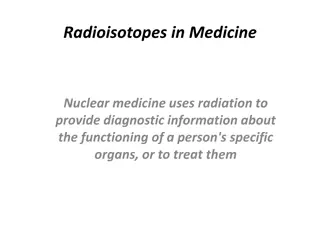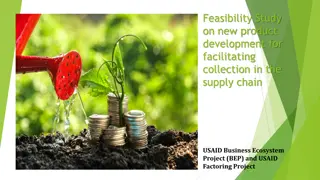USAID Myanmar Market Systems Diagnostic
This document presents findings from the USAID/Myanmar AFDA Market Systems Diagnostic, analyzing changes in market structures and enterprise behaviors to assess inclusivity, competitiveness, and resilience. It covers research methodology, survey population, key findings, and implications for programs. The focus is on understanding market dynamics in Myanmar for effective interventions.
Download Presentation

Please find below an Image/Link to download the presentation.
The content on the website is provided AS IS for your information and personal use only. It may not be sold, licensed, or shared on other websites without obtaining consent from the author.If you encounter any issues during the download, it is possible that the publisher has removed the file from their server.
You are allowed to download the files provided on this website for personal or commercial use, subject to the condition that they are used lawfully. All files are the property of their respective owners.
The content on the website is provided AS IS for your information and personal use only. It may not be sold, licensed, or shared on other websites without obtaining consent from the author.
E N D
Presentation Transcript
USAID/Myanmar AFDA Market Systems Diagnostic Findings August 27th/USAID/Myanmar AFDA Market Systems Diagnostic Findings
OBJECTIVES 1) Provide an overview of the market systems diagnostic analytical tool and research methodology 2) Share an overview the survey population 3) Share key findings and program implications from the analysis 4) Conclusions and Next Steps
MARKET SYSTEMS DIAGNOSTIC ANALYSIS & RESEARCH METHODOLOGY
MARKET SYSTEMS DIAGNOSTIC OVERVIEW Purpose: The market systems diagnostic analyzes changes in market structures and enterprise behaviors to understand how and whether an economy is changing to become more inclusive, competitive and resilient. Method: i) Identify systems-level variables related to competitiveness, inclusion, & resilience ii) Conduct regular enterprise-based surveys iii) Analyze results to identify change that can better inform
HOW CAN THE DATA HELP US? 1) Form a set of hypotheses of how market systems work in Myanmar that we can begin to test to determine where the best places are to intervene in the market system? 2) Measure change across the system - Repeat the survey on a regular basis to determine some degree of change or variance. 3) Getting useful data in the hands of decision-makers and stakeholders
Enterprise Survey Categories 1)Enterprise Overview: ownership, employees, capacity utilization, sales turnover, profits, age of enterprise 2) Customer relationships: number, payment, customer feedback, advertising, and pricing decisions. [Connectivity, Business Norms, Cooperation] 6) Business Partnerships: types of partnerships and alliances [Connectivity, Power Dynamics, Cooperation] 7) Business Development Services: levels, types, and sources of investment to BDS services, recruitment and record keeping practices [Business Strategy] 3) Supplier relationships: number and type of suppliers (demographics), repeat suppliers, embedded service [Connectivity, Business Strategy, Cooperation] 4) Innovation: levels of investment in new products or services and new business models, [Diversity, Competition] 8) Competition [Competition, Power Dynamics] levels of competition in township, region, and internationally, pricing power 9) Inclusion [Business Strategy, Connectivity] engagement with women, youth, and ethnic minorities 5) Access to Finance [Business Strategy and Connectivity] levels, type, source, and barriers to financing 10) Resilience [Business Strategy] types and number of shocks, confidence to overcome supply and demand-side shocks
SAMPLING AND DATA COLLECTION Myanmar-based research agency Thura Swiss contracted by AFDA Farm and non-farm agricultural enterprises randomly sampled from 1,873 firms in ZOI Sample proportions weighted by AFDA s targets in each region 80 questions designed to address the 6 determinants of market systems health Data collection from March 30th May 1st, 18 in-person surveys, 82 telephone surveys, 60 minutes long
KEY VARIABLES ANALYZED Competitiveness Overall profits over past three years Resilience Inclusion Resilience to supply-side shocks Inclusive ownership (females, youth) Annual sales turnover (MMK) Resilience to demand-side shocks Inclusive full-time employment (females, ethnic minorities) Inclusive supply chain (females)
STATISTICAL ANALYSES Dependent variables were either ordinal or interval, sometimes recoded as binary (e.g. 5-point scale of overall performance --> large profits v. other) Attributes and behaviors of enterprises analyzed against all dependent variables Interval data was non-parametric (not normally distributed) IBM SPSS version 26 used for all analyses Tests used: Pearson s Chi-Square test/Fisher s Exact test Wilcoxon-Mann Whitney test Spearman rank-order correlations
OWNERSHIP STRUCTURE, DEMOGRAPHICS & AGE Ownership: 52% were sole owners, while 48% had multiple ownership structures. Gender: 14 female owned enterprises (sole ownership) & 32% of all owners from all companies were female. Youth: 17% had at least one owner under the age of 30 (14 out of 17 were male youth). Age: 31% are fewer than 5 years old and 23% are 25 years or older.
COMPANY SIZE Large and medium size enterprises primarily engaged with on-farm and seed production (42%) as well as value-added processing (34%).
MARKET SYSTEM HEALTH Competitiveness Resilience Inclusion Most enterprises (72%) reported realizing profits (mostly small, with some large profits) over the last three years 68% confidence in overcoming supply-side shocks 32% female ownership 17% youth ownership 52% reported sales of over 100 million kyat ($73,227) 69% confidence in overcoming demand- side shocks 42% female and 58% male full-time employees 7% of full-time employees from smallest ethnic group Women employed more on a part-time basis than men 62% enterprises sourced from at least one female supplier
HYPOTHESES Hypothesis #1: Firms that regularly change key aspects of their business are more likely to realize profits. Hypothesis #2: Enterprises that are part of a business partnership or alliance (technical assistance, machinery, or logistics, etc.) are more likely to have a greater level of confidence in overcoming shocks. Hypothesis #3: Female-owned enterprises have more inclusive and resilient supply chains. Hypothesis #4: Firms that access paid BDS services are more likely to report profits. Hypothesis #5: Small number of specialized service providers results in lower use of BDS services and partnerships. Hypothesis #6: Firms that access external financing are more likely to report large profits. Hypothesis #7: Enterprises operating in Kachin and Shan have greater difficulties doing business with ethnic minority groups. Hypothesis #8: Lack of private-public dialogue leads to a lack of transparency of government policy and decision making.
COMPETITIVENESS Profits - Most enterprises (72%) reported realizing profits (mostly small, with some large profits) over the last three years. Enterprises operating in the Sagaing (15 total) and Mandalay (30 total) regions were the most likely to report having overall profits (either large or small) over the past three years (83.3% and 82.4%, respectively), while businesses operating in the Kachin state (12 total) were least likely. Farms were both statistically significantly less likely to report profits (62.2%) than non-farms (80.0%). Tea sector (80%) had highest rate of profits and the sectors with the lowest reported rates of overall profits was maize (57%), coffee (56%), and pulses (55%).
COMPETITIVENESS Saleswere reported as strong, with one-third of respondents (32.5%) reporting an annual sales turnover of at least 500 million MMK ($366,036 USD) and the top 22.5% reporting sales turnover of 1 billion MMK, ($732,072 USD). Enterprises operating in Kachin state had the highest rates of respondents (42.9%) reporting large annual sales turnover (>500 million MMK). Comparatively, Sagaing and Mandalay reported 23% and 29% of annual sales greater than 500 million MMK, respectively. No enterprises in the pulse sector that reported such high sales turnover (>500 million MMK).
COMPETITIVENESS Enterprises reported larger profits, according to statistically significant correlations, if . they changed a key aspect of their business in their past year. they participate in any business associations. they sought out market information from print media or the radio in order to determine the pricing for their goods and services. they utilized an electronic platform for their record-keeping.
COMPETITIVENESS PROGRAM IMPLICATIONS Building the business case - Use the business behaviors that are correlated to profits to build a business case for performance improvements. Investigate why microenterprises are less likely to invest in new businesses or enterprises (63% versus 86% for other sized businesses). Analyze how gross and profit margins are spread across value chains and sectors to understand if margins are being shared equitably and why farmers are reporting lower break-even rates than other types of business.
RESILIENCE Confidence in Overcoming Shocks - Two-thirds of all respondents reported that they were very confident in their abilities to overcome both supply-side and demand-side shocks (68% and 69%, respectively). Majority-female run businesses were more likely to rate themselves very confident in overcoming supply-side shocks as compared to joint or majority-male owned enterprises (79% compared to 65%). Enterprises operating in Mandalay had the highest rates of very confident responses in overcoming supply (82.4%) and demand-side shocks (85%). Kachin state had the lowest rates of very confident responses (50.0%) and highest rates of not confident responses (25.0%). Farms had the lowest rates of being very confident (57.8%) and the highest rates of being somewhat confident (28.9%) in overcoming supply-side shocks. Horticulture (73.5%) had the highest rates of very confident responses compared to pulse, oilseed, or tea sectors (45.5%, 50.0%, and 53.3%, respectively).
RESILIENCE Profits linked to Resilience - As confidence in an enterprise s ability to overcome any supply or demand side shocks increased, enterprises were more likely to have reported higher overall profits over the past three years. Higher Productivity linked to Resilience - Enterprises utilizing a greater portion of its production capacity were more likely to have higher levels of confidence in overcoming both supply and demand side shocks. Supply-Side and Demand-Side Confidence linked - Levels of confidence in overcoming demand-side shocks are significantly, positively correlated with those for overcoming supply-side shocks. Higher Number of Shocks = Lower Confidence - As the number of types of shocks experienced increased, enterprises degree of confidence in overcoming demand-side shocks decreased. Business Partnerships = Higher Resilience - Enterprises that were part of a business partnership or alliance (technical assistance, machinery, or logistics, etc.) were more likely to have a greater level of confidence in overcoming shocks or interruptions to the market. Greater Pricing Power = Higher Resilience - Enterprises with greater pricing power were more confident in their ability to weather demand-side shocks, as a greater degree of pricing power could imply greater customer loyalty or perhaps a monopoly position in the market.
RESILIENCE PROGRAM IMPLICATIONS Study resilience and inclusion capacities of female entrepreneurs - Studying why female enterprise owners reported more resilient and inclusive supply chains. Study market structures in conflict-affected regions - Study market system structures carefully in the ethnic minority regions of northern Shan and Kachin to determine what types of market functions and enterprises might be most vulnerable to shocks and look to facilitate greater investment or innovation in those areas. Study and promote risk mitigation mechanisms (particularly for farm producers) Study why farmers reported lower-levels of confidence in overcoming supply-side shocks. Promote risk mitigation mechanisms within the agricultural system, particularly for businesses that were less resilient to shocks, such as insurance products and improved supply chain and business relationships.
INCLUSION Ownership - Most enterprises have male and mature ownership, i.e. men between the ages of 30 to 49. Mandalay has higher rates of majority-female enterprise ownership (29%) than all other regions combined (14%). Kachin, youth ownership is highest, with a third of all enterprises owned by at least one youth representative. Seed enterprises have youth ownership rates of 25% (meaning, at least one owner was under 30), and at the low end, plant protection and fertilizer enterprises only had 7% youth ownership. Employment - Women comprise 42% of full-time employees in the enterprises surveyed, while men comprise 58% of full-time employees. Women, however, seem to be employed more on a part-time basis than men. Employment of ethnic minorities was not as common. Suppliers 62.0% of all enterprises utilized at least one female supplier for their business. Younger businesses, those that were five years old or less, had much higher average rates of using female supply firms, at 36.9%, compared to 23.7%. Enterprises that have more females in ownership positions, tend to hire more women or ethnic minorities as full- time employees.
INCLUSION Profits Linked to Female Full Time Employment - Enterprises reporting large overall profits from the past three years had higher rates of full-time employees that are female than enterprises reporting large overall losses (58.3%). Sales Linked to Full-time Employment of Ethnic Groups - Enterprises reporting higher levels of sales turnover also had higher rates of full-time employees from their region s smallest ethnic group(s). Large Enterprises Employ More Female Employees - The largest enterprises employed the highest rates of female employees. At the same time, the largest enterprises had the lowest rates of female ownership. Female-owned Enterprises Provide More Support to Suppliers - Enterprises providing trainings or other support services to their suppliers were more likely to have greater ratios of women in ownership positions, have greater rates of full-time female and ethnic minority employment, and report using a great percentage of female-run suppliers.
PROGRAM IMPLICATIONS Expand female entrepreneurship Consider promoting more female agriculture entrepreneurs through accelerator programs and encouraging larger enterprises to hire more female owned suppliers to decrease the gender gap in agricultural enterprise ownership. Conduct further Studies on Employment Practices and Profitability - Additional research is needed to validate connections between enterprise profitability and employment practices (eg: equitable wages) in order to strengthen the business case for inclusive hiring and sourcing practices.
COMPETITION Enterprises report mixed levels of competition - At the regional (38%) and township (43%) levels enterprises reported healthy levels of competition while, about one-third of respondents reported that the market was dominated by one or a few large firms at the regional level (35%) and township level (29%). Healthy mix of old and new companies - A healthy balance between companies that have been operating for a long period of time (28%) (>31 years), which likely means multi-generational businesses, and companies established more recently (31%). High Entry Costs - Firms in the agricultural and natural resources sector face greater perceived entry costs than firms in others sectors as well as land access and security, particularly in areas affected by conflict (Asia Foundation MBEI). Maize more monopolistic? - Maize sector enterprises reported the domination of one or a few large firms (57% said this for both the regional and township level), while enterprises in the spice sector reported low rates of monopolies (17% for both the region and township). High Rates of Innovation! - Over half of the enterprises surveyed (59%) reported launching a new product or service within the last year and 64% reported changing one or more key aspects of their business, of which the vast majority (92%) said increased profits or other aspects of their business.
COMPETITION PROGRAM IMPLICATIONS Accelerate growth and innovation without distortion Leverage high levels of competitive behavior, by helping accelerate growth of innovation and value-added products and services, without disrupting the healthy competition that currently seems to exist across most of the ZOI. Increase Use of BDS Services - In support of promoting innovation and growth, AFDA should focus on increasing investment and adoption in professional business development services sector in order to expand the needed technical, logistical, and administrative services enterprises need to compete effectively.
COOPERATION Support to Suppliers - Just under half (42%) of the surveyed enterprises reported that they provide additional services, trainings or other support to their suppliers. significant relationship between providing supports to suppliers and higher levels of female-owned enterprises. Enterprises in the oilseed sector were less likely (17%) to support their suppliers than enterprises in all other sectors (46%). Enterprises in the coffee sector were more likely (78%) to support their suppliers than those across all other sectors (39%).
COOPERATION Less Cooperation Outside of Supply Chains - While there is a lot cooperation within supply chains, there was a lot less cooperation across enterprises within the broader market system. Only one-fifth (20%) of enterprises reported having any kind of partnerships or alliance with other businesses. Seed enterprises were more likely to engage in partnerships/alliances (42%) than enterprises engaged in other activities (17%). Enterprises in the coffee (44%) and horticulture sector (29%) were significantly more likely to be part of a partnership/alliance than those across other sectors (15%).
COOPERATION PROGRAM IMPLICATIONS Ensure Additionality with Supply Chain Interventions - Provision of support for suppliers does not appear to be a new practice (unless it is new to a particular sector), therefore, partnership development should consider the additionality of such support, if this is already a common practice in the agricultural market system. Facilitate more B2B Partnerships - The lack of connectivity outside of supply chains does appear to be an area of improvement. Market facilitation should focus on increasing greater connectivity in the market system, be they on an individual basis, or through establishment of marketing platforms.
BUSINESS STRATEGY Customer Loyalty - Enterprises seemed to indicate a high level of customer loyalty, with 64% percent of firms reporting that 76% - 100% of their customers were repeat from the previous year. Similarly, there seems to be high levels of supplier loyalty in the market system. Investment in Innovation - There was a high-level of investment in innovation among firms (64% of surveyed. High levels of capital expenditures as a percentage of external finance (56%) is allocated for capital expenditures (machinery, investment, technology, etc.). BDS Services - Only 36% of respondents reported paying for external business development services (BDS). Most enterprises satisfied with quality of BDS. Those that did not use them said the had no use for them. When enterprises were satisfied with most or all of the BDS services they paid for, they were more likely to report seeing profits.
BUSINESS STRATEGY Record Keeping - 78% of surveyed participants still use paper or a mix of paper and 47% use an electronic system. 17% of enterprises keeping records electronically had large profits over the past three years, compared to just 6% of those using either paper record systems only. Marketing - More than half of the respondents (51%) do not use any marketing strategies or advertising methods. Facebook was the most popular marketing strategy for enterprises. Forty percent of enterprises using TV ads reported seeing large profits, compared to 10% of all other enterprises.
BUSINESS STRATEGY PROGRAM IMPLICATIONS BDS Market Analyses - Further research is warranted to understand the reasons behind low use of external BDS services despite enterprises being motivated to grow and expand their businesses. As well, more research is warranted that will help determine the types of external BDS that could be most beneficial to different types of enterprises. Promote Further Digitization of Enterprises - Promote the digitization of business operations.
DIVERSITY Limited diversity among supply chain structures (albeit from a small amount of data) More than half the respondents (53%) relied on between 1 and 5 suppliers. 78% of enterprises changing less than 25% of their suppliers over the past three years. Limited Market Channels - Enterprises reported relying on a small number of customers to sell their products and services, with 56% of surveyed firms reporting having between just 1 to 20 customers. Market Actor Inventory - Data from AFDA s agricultural inventory study indicates a somewhat even spread of the 5,739 enterprises identified across the five regions in the ZOI. Mandalay is the largest outlier, having 48% of the total enterprises. Inventory identified a diversity of downstream and upstream businesses from the total population (see table below). Most notable are the large number of processing enterprises (29%) and logistics providers (22%). The smallest number of market actors was in specialized services such as standards and certification (8 total), marketing services (7 total), and BDS providers. Pulses and oilseeds, Myanmar s two largest agricultural sectors, have a smaller number of enterprises as a percentage of the total than smaller sectors such as tea and horticulture.
DIVERSITY PROGRAM IMPLICATIONS Facilitate Greater Supply Chain Redundancy - While positive that enterprises are satisfied with the quality, price and timeliness from their suppliers, it has likely led to some complacency and reliance on a smaller number of trusted suppliers. This can present some risk to supply chain shocks. Market facilitation efforts should consider raising this issue among medium and larger sized enterprises and help facilitate greater redundancy within their supply chains to source commodities across different regions in the ZOI. Why are there lower numbers of oilseed and pulses enterprises? The agricultural inventory study and subsequent maps provide very detailed information to determine diversity by geographic region. It would be worth exploring what is behind the lower numbers of enterprises in the oil seeds and pulses sectors, and whether this might be limiting competitiveness or resilience in the market system.
CONNECTIVITY Supplier & Buyer Relationships - Enterprises, on the whole, reported having a limited number of supplier and buyer relationships while also indicating high levels of satisfaction and trust within those relationships. 57% of enterprises reported having 0% to 50% of their customers that paid after delivery. Reported high-levels (55%) of customer feedback collected by enterprises, primarily to improve the quality of their products and services. The majority of this feedback is collected in-person (67%) and over the phone (47%). Embedded services to suppliers - Services such as extension, training, or input supply are another indicator of strong connectivity. Connectivity with fee-based business development services is limited to only 36% of enterprises. Partnerships with other similar businesses is limited to only 20% of enterprises. High participation rates of business associations (70%). External Financing - Connectivity with the finance sector is mixed, with half of enterprises reporting no sources of external financing. Firms that made the decision to use external financing were more likely to report large profits (18%) as opposed to anything less than large profits (4%).
CONNECTIVITY Inclusive Business Practices Connectivity between enterprises and vulnerable groups varied. For example, 62% of enterprises reported sourcing products from women-owned businesses or households. Additionally, over three-quarters of respondents (77%) reported no problems conducting business with members of ethnic groups outside their own. Kachin and Shan states, where 42% and 36% of enterprises reported challenges in doing business with ethnic minority groups. Infrastructure as Gap to Connectivity - Infrastructure as a major impediment to doing business in Myanmar (Asia Foundation MBEI). Enterprises expressed dissatisfaction with road quality and electrical power (only 49% of firms say these features are good or very good). Firms are more positive about the telephone (66% report good or very good) and Internet (54% report good or very good).
CONNECTIVITY PROGRAM IMPLICATIONS Understand Payment Delays Investigate further whether payment delays is limiting purchasing power within supply chains and if so, work with financial institutions to help free up working capital. Customer Relationship Management Systems - Given there is already a practice of collecting customer feedback, facilitation could focus on introducing customer relationship management systems to help enterprises manage their relationships and interactions with customers easier, rather than manually over the phone or in person as it is currently being done. Mobile Extension and Communication Understand the effectiveness and quality of embedded ag extension services and see what upgrades could be made, either through mobile extension or introducing more modern farming practices. Ethnic Minority Supply Chains Follow-up with enterprises reporting difficulties working with ethnic minorities and determine if there is a need for community or local systems dialogues. Support businesses and communities to lobby and advocate to government for improved infrastructure as well as link to other donor programs working on electric and road improvements when possible.
POWER Pricing Power - Pricing power was mixed across enterprises that stated potential losses if they were to raise prices by 10%. Forty percent of enterprises reported a potential loss of 25% or fewer customers, 24% of firms reported a 26%-50% potential loss, and 29% reported a 76% or greater loss in customers. Advocacy -Businesses reported few types of formal business alliances. For those that did have alliances, none of the enterprises mentioned forming any alliances to influence government policy. Business Enabling Environment - The Asia Foundations MBEI report noted significant issues with government transparency. Only 3.6% of firms report having access to the state or region budget, and only 4.3% of firms report having access to new investment plans. Firms in the agricultural and natural resources sector face greater perceived entry costs than firms in others sectors as well as land access and security,
POWER PROGRAM IMPLICATIONS For those enterprises or sectors where price sensitivity among customers is high, investigate avenues for product or service differentiation so that they could have stronger position in the market system. For those firms working in commodity markets, a low price strategy maybe more efficient. Further research is needed to understand the extent to which business associations have the potential to influence policy decisions, given that participation in business associations is very high (70% of respondents).
NEXT STEPS Validate Key Findings - Validate the key findings with other on-going research and stakeholder/respondent interviews. Prioritize Market Systems Health Indicators - Select which are the most important indicators to track (based on our targeted system changes and areas of interventions) from the MS Diagnostic. Expand survey with a statistically significant sample size of enterprises moving forward. Track and monitor key market systems health indicators - Use the MS Diagnostic to track changes in market system determinants and outcomes over time. Share relevant findings of diagnostic with decision-makers to have policy or business decision making influence.























